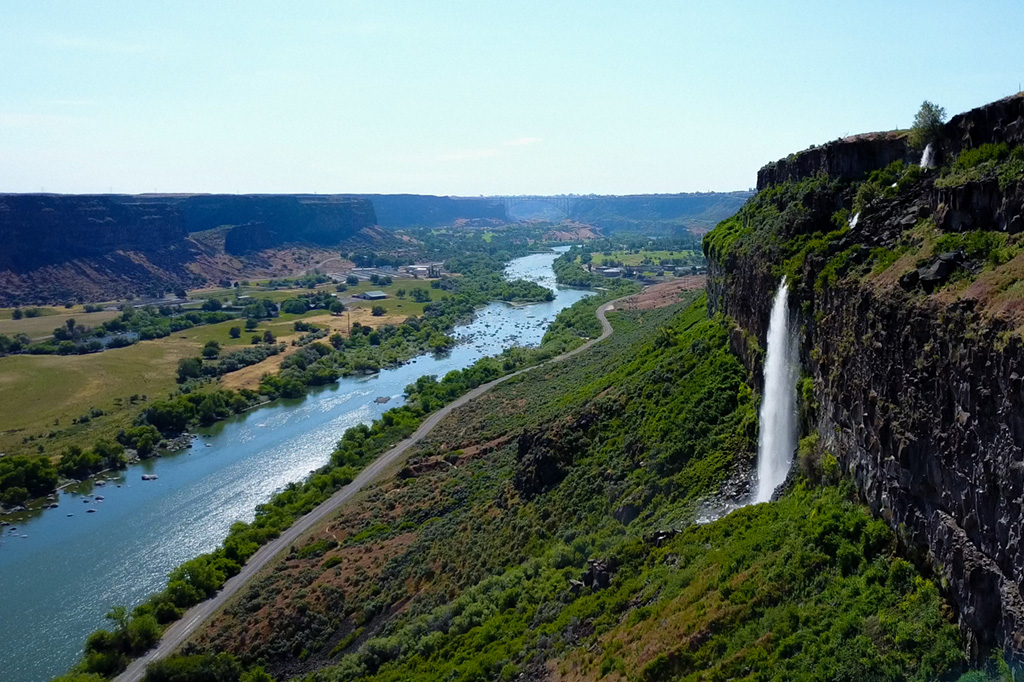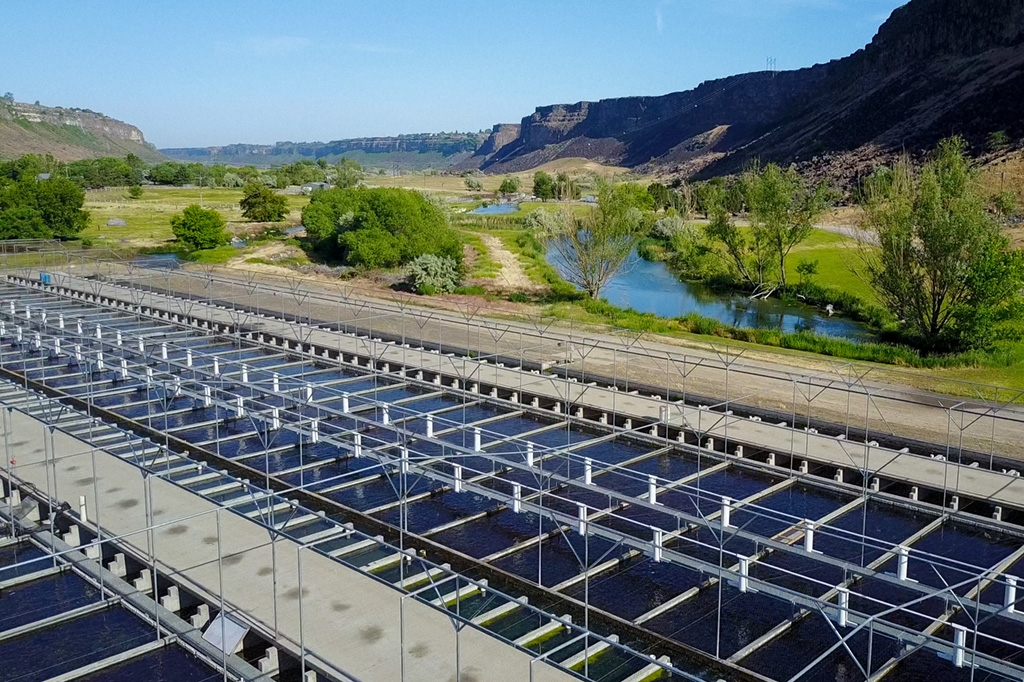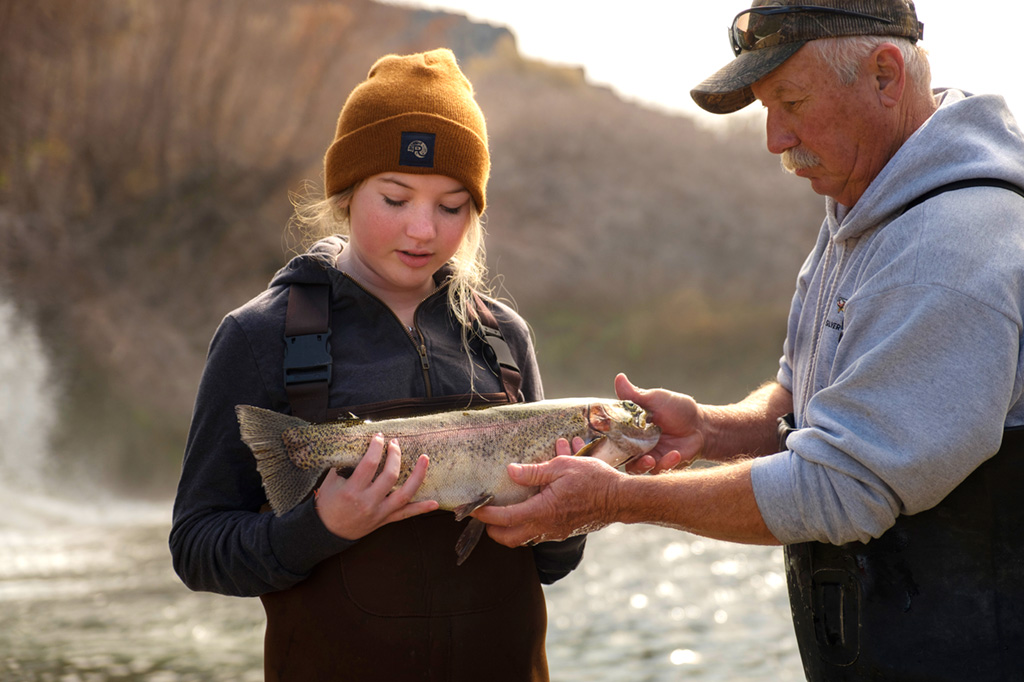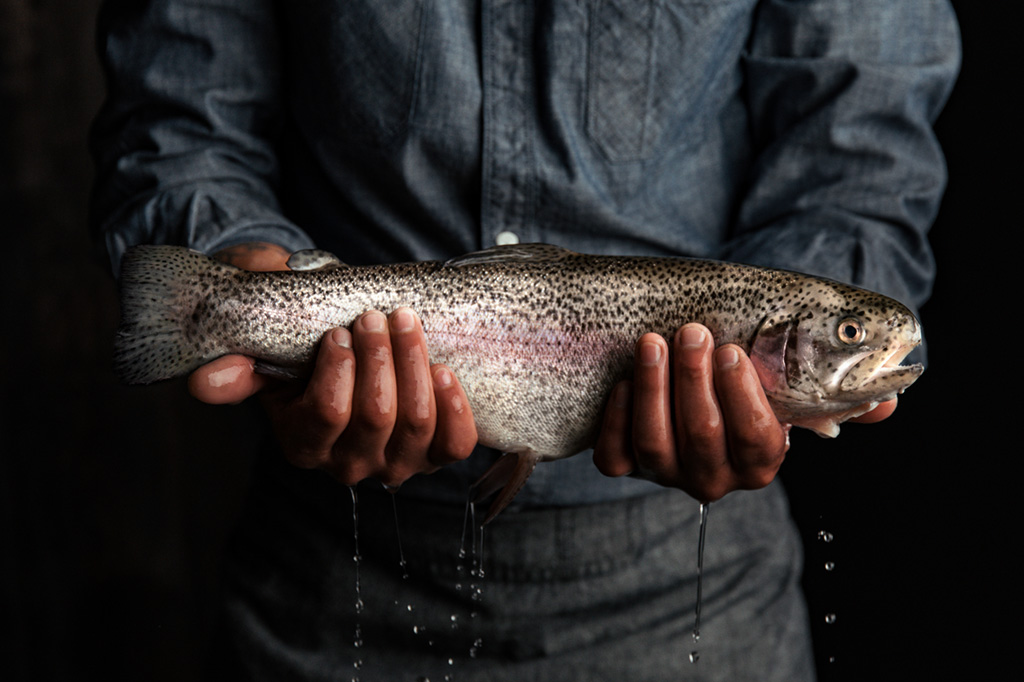Idaho trout: local and delicious.
That’s the promise touted in restaurant menus across the Gem State. After all, short of a russet, what dining experience could be more Idahoan than a trout harvested in the Magic Valley?
Tourists at The Sawtooth Club in Ketchum might consider the Idaho ruby red trout, “a boneless filet, apple-wood grilled, brushed with house-smoked roasted red pepper butter, served with wild rice pilaf.”
Diners at Sockeye Brewing in Boise might be tempted by the 8-ounce pan-seared trout from Hagerman, “topped with a sage, lemon and pecan pan sauce, served with chef’s sautéed vegetables and garlic smashed potatoes.”
The trout beautifully arranged on those steaming plates indeed comes via a two-hour truck ride. And, just like Idaho russets, those trout are grown and harvested from fish farms. The Sawtooth Club and Sockeye Brewing’s filets come from Riverence, an aquaculture company operating near Filer. Riverence has become popular for Sysco, which delivers food to most Idaho restaurants. That’s because the quality of Riverence trout is consistent and available at a stable price, year-round, making it a favorite for Idaho chefs, Sysco culinary consultant David Knickrehm explained.
“When tourists come to Idaho and want an Idaho experience, in a state known for the outdoors, what’s better than to serve local, Hagerman Valley trout that is absolutely perfect?” Knickrehm said. “And it is.”
Riverence fish are already distributed across the country, and its trout and salmon eggs grown in Rochester, Wash., are delivered to fish farms around the globe. Its founders hope that, as Americans’ appetite for seafood grows, Riverence can take a bigger bite out of a seafood market mostly supplied by imports. To do so, the company must continue selling consumers on its quality while telling its story—namely, why customers should trust it as a player in an aquaculture industry that has its share of skeptics.
That Riverence story starts with Colorado cows, West Coast salmon and more than a few Emmy Awards.
It goes like this.

Idaho is ideal for trout farming thanks to its abundant spring water. Pictured above is the Snake River and the Riverence facilities in the left background. Photo courtesy Riverence / Gabe Watkins.
Cattle, Hollywood and Trout
Chances are you haven’t heard of David E. Kelley, who came up with the idea for Riverence. But chances are you have heard of the fruits of some of his other ideas: “Ally McBeal,” “The Practice,” and “Big Little Lies.” That’s because Kelley created those famous TV shows, as well as creating or writing for a laundry list of other shows and movies made for TV. You’ve probably also heard of Kelley’s wife of 25 years, Michelle Pfeiffer, who has graced the silver screen in major movies since the early 1980s.
One of Kelley’s favorite non-Hollywood pastimes is sport fishing in coastal Alaska and British Columbia. That passion led to Kelley mulling the future of wild salmon and other fish facing pressure from deteriorating habitats, commercial fishing and potential threats from global warming. So, he got in touch with a longtime business associate, Rob Young, a sixth-generation cattle rancher.
“[Kelley] came to me with the idea that there must be a way to do production aquaculture and reduce pressure on wild stocks,” Young said. “He came at it from a conservationist mindset, and he knew I’m a little bit obsessive about efficiency and sustainability.”
By that, Young means he’d become preoccupied by the exponential growth in the world population, which has roughly tripled since 1951. Farmers responded to the increase in hungry mouths by automating operations and mass-producing food, he explained. But many of those practices aren’t sustainable, and with the population continuing to swell, Young believes something has to give.
“The model we’ve worked under for the past 90 years isn’t sustainable,” he noted. “More people today might live, but are they living well? When is the tipping point?”
Young knew little about aquaculture. However, he knew all about cows, which his family had raised for more than 100 years on its Colorado ranch and in Switzerland before that. During that time, the cattle industry made leaps in nutrition and breeding for larger, healthier animals.
After studying aquaculture, Young said he was impressed that fish farming was more efficient in converting feed into pounds of protein than livestock industries. However, where ranching operations continued to evolve in recent decades, he thought aquaculture stagnated. He told Kelley they had an opportunity to move fish farming forward, and the partners founded Riverence.
“I thought aquaculture had rested on its laurels for a bit,” Young said. “We came with fresh eyes. Typically, in business, you’ll hear, ‘This is the way we’ve always done it.’ I saw a lot of that in aquaculture.”
Aquaculture 101
Fish farming has its critics. Young and his Riverence employees say they embrace opportunities to explain to customers how some assumptions about aquaculture are misguided, and also to talk through how Riverence’s methods address remaining concerns surrounding the environmental impact of its operations and the safety of its farmed trout (and some salmon). But before engaging in that conversation, consumers should know a little bit about the broader aquaculture world.
More than 80 percent of all seafood consumed in the U.S. is imported, according to the National Oceanic and Atmospheric Administration, or NOAA. Aquaculture produces about half of the seafood consumed in the world, and farmed seafood production has increased 8.3 percent annually since 1970, making it the fastest growing method of food production in the world, according to NOAA.

The “raceways,” where fish are raised at Riverence’s Blue Lakes facility in Twin Falls. Photo courtesy Riverence / Gabe Watkins.
However, the United States remains a small player in the industry. Aquaculture here has more or less plateaued in recent decades. The U.S. is the 13th largest aquaculture producer today. Meanwhile, China’s aquaculture industry now produces 62 percent of the world’s farmed fish and shellfish.
Seafood farmed domestically is subject to federal regulation, which could satisfy some consumers. But most aquaculture products come from overseas, making it hard to know if a given product contains more antibiotics than is allowed here, or has adverse effects on the environment, said Roy Hillborn, a professor of aquatic and fishery sciences at the University of Washington.
“There’s big concerns about overusing antibiotics, both in livestock and in aquaculture,” he said. “The Norwegians reduced their antibiotics use by a hundred-fold, where the Chileans were using large amounts. It’s really hard for consumers to know what they are buying.”
Domestic fish farms are more environmentally friendly. Some countries allow damaging aquaculture practices, and even if they don’t, those products must be flown to the U.S., creating a large carbon footprint. Trout raised and consumed in Idaho should typically be more sustainable.
Hillborn has studied the environmental impacts of wild and farmed fish in comparison to other livestock. Idaho-farmed trout fares well, he said. It’s tricky analysis. Wild seafood requires fuel to catch, so deep-sea fisheries, such as tuna, tend to have a larger carbon footprint than salmon harvested in coastal fisheries. Though even that has a caveat: fish farms create a carbon footprint where the feed is harvested, which might be across the globe. For example, much of the soy that fuels Norwegian aquaculture is grown and imported from Brazil, Hillborn noted.
Idaho trout fares comparably to some wild-caught fish, according to Hillborn, and is far more environmentally friendly than livestock industries. (There’s no wild-caught trout industry, so Hillborn used salmon as an example.)
“Farmed salmon are more sustainable than chicken, pigs and beef,” Hillborn said. “Should people eat farmed salmon? Wild salmon would be better, but there’s only so much wild salmon in the world.”
Gauging wild-caught seafood is tricky, too. According to Hillborn, U.S. fisheries are generally well managed, ensuring natural stocks won’t be endangered by overfishing. Some Alaska wild stocks are enjoying record returns. However, wild fish and shellfish populations have dwindled in certain fisheries and in certain regions, and healthy natural stock populations rise and fall, causing volatility in supply and prices. But, as is the case with farmed products, most of the wild-caught seafood in the U.S. comes from foreign fisheries where overfishing may threaten wild stocks, as is the case with several species of tuna.
Long story short: Whether it’s wild or farmed, most consumers will have a tough time parsing which seafood products are sustainable for fish stocks as well as for the environment. The simplest homework might be to trust organizations that research and grade fisheries and aquaculture operations, such as the Monterey Bay Aquarium Seafood Watch, which rates wild and farmed seafood products as a “best choice,” “good alternative” or “avoid.” Riverence uses flowthrough raceway pens, which have moving water, mimicking a stream. Swimming against the current helps the fish create muscle mass. The watchdog organization lists trout raised in outdoor flowthrough raceway pens—the type used in Idaho—as a “best choice.”

Farm manager Tom VanTassel teachin Kai Young about aquaculture. Photo courtesy Riverence / Gabe Watkins.
The Riverence Way
Thankfully, understanding Riverence and its practices is simpler than untangling conditions in the many fisheries and fish farm environments across the world.
Trout farming typically breaks into two separate operations: breeding facilities, which produce eggs, and farms, which buy eggs, hatch the fry and then raise the trout for two to five years before harvest.
In the livestock world, there’s constant communication between the two sides, Young said. Ranchers carefully track cow health. That data informs the selective breeding, which continues to take great strides, he said. The result is larger animals that are more resistant to sickness.
Jason Mann, Riverence director of nutrition, has worked in various corners of the aquaculture world for three decades. In his experience, only half or a third of trout eggs survived. That low number convinced the owners to invest millions in their own breeding facility, where the company crossbred more than 100 trout families, including Idaho species. (Idaho trout provide the genetic spine of most trout farmed in the world, Mann said.) As a result, Mann explained, more than 90-95 percent of Riverence eggs survive from fertilized egg to what’s known as the “swim-up” stage, a critical milepost in the life of fish. Once hatched, Riverence eggs produce fish that grow 30 percent faster than those from eggs purchased. Farms across the world buying those eggs have reported strong results as well, he said.
Young is concerned about the overuse of antibiotics across the globe, in part because he was resistant to antibiotics after contracting E. coli while traveling in Peru. He said Riverence administers antibiotics only when fish are sick, “just like you would for your child or pet,” in order to keep them alive. Riverence does not administer blanket antibiotics, as can be the case overseas. Riverence fish survive at a high rate because of superior breeding, Young said. “We’re trying to give these fish a healthier head start and a healthier life cycle. I’ll be bold and say I think we’ve done that in spades.”
Riverence maintains its fish are not genetically modified. Young says he often explains to customers that selective breeding—choosing parents based on traits—is different from manipulating the genes themselves. The meat you buy in stores is the product of selective breeding.
Hillborn, the marine biologist, noted that fear about genetically modified food is overblown anyway. “There’s an enormous amount of hysteria about gene technology,” he said. “Every major study, even about the ‘Frankenfish’ with genes from two different species, has never shown any evidence it’s harmful to humans.”
Another concern about farmed fish as well as GMO crops is that either could devastate natural populations if they were allowed to crossbreed. Experts feared the worst in 2017 when as many as 263,000 Atlantic salmon escaped from saltwater holding pens into Puget Sound in Washington State. The fish farm operator was deemed negligent for failing to maintain the pens and was fined $332,000 by the state.
It’s safe to say that Riverence, which operates an inland fish farm and gets its water from natural springs, will never have a major escapement.
Positive Reviews
Chefs can be a picky bunch, Knickrehm said. However, the chefs Sysco sells to give Riverence fish high marks for flavor and consistency, which isn’t always the case for every product.
“We expect certain variances in fish. With Riverence, there’s almost no variance at all,” Knickrehm said. “It’s perfect every single time. It has the tightest quality spec of any company I’ve dealt with.”
Knickrehm acknowledges that farmed fish face a marketing challenge. But the chefs Sysco distributes to swear by Riverence fish, and farmed fish offer the same Omega-3 fatty acids that nutritionists say offer a litany of health benefits, including brain development, mental wellbeing, and heart health. Perception of farmed fish will change when chefs and consumers learn about operations like Riverence, he said.
“Wild-caught definitely has a better image. Chefs are conditioned to say they only use wild-caught,” Knickrehm offered. “But this is a sustainability issue. I think farmed fish is the wave of the future. If the practices at Riverence for feeding, care, and development of healthy fish caught on across the market, I think the entire public perception would change.”
Idaho fish farms have a chance to brand Idaho trout the way the Idaho Potato Commission branded Idaho potatoes, Knickrehm pointed out. Consumers have an easier time feeling good about buying local, he said. “Things like antibiotics are a concern among consumers, but you can put that argument to bed with Riverence because we know where the products are coming from. Chile produces a lot of excellent products, but it doesn’t allay that concern.”

